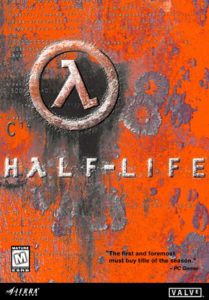Steam: Digital Distribution Pioneer

Steam: From pushing game updates to a digital distribution platform
Steam: Digital Distribution Pioneer
Valve & Steam
Valve gained prominence as a video game manufacturer through its’ award-winning single player game Half-Life, created in a time before mass high-speed internet adoption.
Half-Life
Through continued support for its’ games, Valve realized that a majority of their users had access to high speed internet access. Brainstorming on how to deliver a streamlined channel of continued game support, Valve decided to create Steam. Valve expanded Steam into a direct to consumer retail channel.
While early adoption was slow, and Steam was not required to play Valve games initially, a superior royalty structure and easier way to reach consumers directly lured third party software makers to the platform.
Value creation
Steam enables seamless search, rating, trial, payment, download, community and game host/launching capabilities. While Steam was initially launched as a game and update distribution vehicle for Valve’s games, the platform was opened to third party manufacturers. Increased competition between Valve and third party manufacturers lead to higher quality experience for all users. Game demos and trailers added to user experience.
Steam store sports 4000+ games or offerings. Steam also provides an online community where gamers can build relationships, providing a depth of entertainment quality and experiences and extend the life of both games and gamers.

The Steam Platform
Steam serves the multiplayer gaming communities by providing services such as matchmaking and anti-cheat protection. Virtual items, virtual currency and trading between players and stores provide further value to the users and revenue outlets for game makers. Through network effects, Steam provides increased competition, community, user & game selection.
Value capture & business model
Valve takes a ~30% revenue royalty for hosting third party games on Steam. Software manufacturers competing with Valve are paying a fee for access to Steam’s 125MM users, adding variety and attracting more users to Steam. Concurrently, Valve utilizes royalties to enhance Steam and cross-subsidize its’ in-house game development.
Growing Steam
Valve pioneered the freemium model, attracting new users to the Steam platform through free games. The increased userbase resulted in increased in-game virtual store revenues (through purchase “e-swag” such as skins – non-performance enhancing distinctive items). League of Legends, one of the most popular third party games estimated to make over $1B selling cosmetic items in 2014 [X]. Furthermore, the new Steam platform users bought more games, making the platform more valuable to all parties.
“F2P”
Meet the engineer: award-winning content from Valve
Valve as a new entrant & market leadership
Prior to Steam, game makers had to find a publishing house to partner with and/or, self-finance physical copies and find retail partners such as GameStop or Target to sell through. Pirated distribution captured a large portion of distribution and Valve viewed piracy as a distribution challenge.
Game platforms at the time were either Microsoft or Mac OS, or dedicated hardware + software gaming bundles such as Microsoft Xbox, Sony Playstation & Nintendo 64. Stand-alone gaming machines such as the Xbox did not necessarily have fast internet connection. The lack of a focused distribution platform on the PC market, increasing availability of high speed internet and easy access to award winning games brought in users. Low capital cost of adoption, instant access to users & reduced need to spend marketing dollars were winning proposition for smaller developers. The addition of “indie” game makers increased the platform’s value. Big name developers followed.
Multihoming, competition & expansion
While some games can still be purchased through retail channels, or through third party platforms, Valve controls the largest stake in the computer platform business. Some games require both authentication through Steam and through third-party platform systems. However, most third-party platforms sport inferior quality and/or product offering, providing for reduced incentive to adopt non-Steam platforms.
Blizzard, a successful game manufacturer, maintains a platform to retain revenue. Blizzard’s platform hosts only in-house games. Blizzard’s award-winning products, led to adoption of its’ limited platform, which is required to play the games.
Aware of the market leadership and decline of the computer market, Valve is venturing into settop gaming box business with SteamBox & controller, competing directly with Microsoft Xbox and Sony Playstation. Valve has expanded offerings through movie distribution deals (i.e. w/ Lionsgate), SteamMusic, in-game streaming and providing new VR content and hardware. Steam Linux & Mac OS versions and the creation of SteamOS have hedged Microsoft OS platform risk.
http://www.gamesindustry.biz/articles/the-last-of-the-independents-
http://www.complex.com/pop-culture/2013/12/gamers-steam-need-to-know/steam-machines
https://www.forbes.com/sites/insertcoin/2012/02/16/the-numbers-behind-steams-success/#5ec3fb01470f
http://media.steampowered.com/apps/tf2/blog/images/blog_chars_base3.jpg
https://ucarecdn.com/ba60c2b3-2916-4c55-8936-c412caded702/
http://cdn.akamai.steamstatic.com/steam/apps/70/header.jpg?t=1447890508





Great posting, Boris! Do you think Steam could/should go Mobile? Or is that too massively controlled by the App Store and the like? How about introducing tools (not only games) on the pcs/macs?
Yes to both questions! Hearthstone, one of Blizzard’s most popular games has been making more money from its’ mobile users than its’ PC users (http://toucharcade.com/2015/07/22/hearthstone-mobile-earnings-surpass-desktop/). However, in the question of competitive cross-platform competition, PC gamers have been considered superior than other platform gamers (e.g. XBox). One of the reasons for Hearthstone’s success has been its’ design for the touchscreen.
On the question of tools, I believe Steam already has productivity applications including design, animation and video production. Steam still weighs heavily towards games, however.
Really interesting post. Fascinating that after all it’s done to build a platform as an alternative to game consoles, Valve is now going into that business. I think Yuval raises a good question about mobile — as a non-gamer, I’m in the dark about whether the App Store really offers that same kind of community that Steam does. If not that, seems like they should be able to come up with something in the mobile space to create/capture value with 125M users!
Brad, take a look at Hearthstone for mobile. Although not quite as fast moving a game as some of Valve’s PC/Steambox multiplayer games, it is a small step forward for mobile gaming.
Love it Boris! Interesting to see how they are even forcing big developers such as Ubisoft into using their platform. And that they are essentially becoming the new playstation / xbox platform – generating a fee from each game, without actually creating it yourself. With their latest step into hardware I am very very curious how it plays out. Do they have the capability to build, market and distribute a console like PS and Xbox do? And: how will those platforms respond? I can imagine that PS and Xbox will start to attack Steam in retaliation (for instance by forcing game developers into making more exclusive content?)
Good points Danny – XBox and PS4’s part strategy is to have exclusive games to the platform (e.g. like Microsoft’s Halo franchise). Steam hardware is a bit early in the game. Valve/Steam are experimenting with PC relays to the big screen, as well as with stand-alone console format Steam machines.
That being said, Xbox is innovating to stay relevant with a subscription like model similar to Spotify or Netflix: http://gizmodo.com/xboxs-new-gaming-subscription-is-just-what-the-struggli-1792821461.
Thank you Boris, I think that’s a logical step in evolution of Valve. They have created the top games on the market and needed to monetize their success by creating a platform for games distribution. So far it looks it works well, but I suspect Apple, Google and Microsoft will compete with Valve in game distribution. They all have similar platforms that create value by distributing video games. By that time Valve will need to develop some locking mechanisms to lock up its users or develop some other competitive advantages. Global video games market in 2016 is estimated at almost $100 bln. 30% of it is a huge value capture and a very attractive piece of pie for competitors.